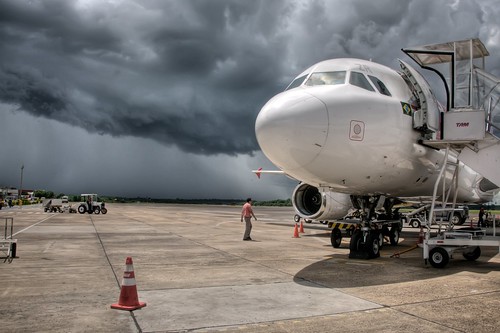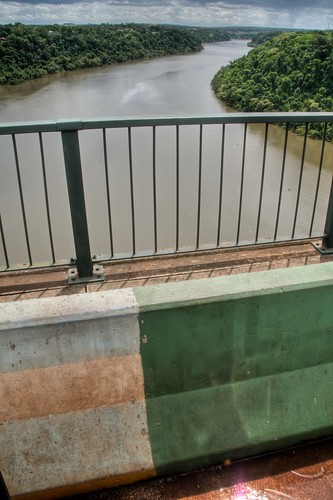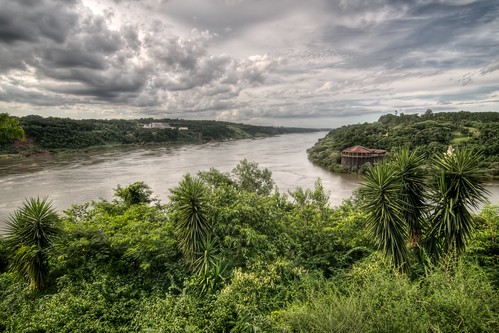The Sleepy Town of Puerto Iguazu
After landing in Foz do Iguacu, ferocious storm clouds rolled over the airport. Sure enough, after collecting our bags, the monsoon-like rains came, but only for a few minutes.
A driver named Cesar was there to pick us up. The speed as which he got us into Argentina was amazing. While other tourists waited in lines to have their paperwork inspected and bags searched, Cesar ran inside with our passports and came out with stamps. Nobody ever even looked at us or our bags.
A few moments later, we were crossing a bridge over the Iguassu River, which marks the border of Brazil and Argentina. Cesar stopped the van at just the right spot so that Gog and I could experience the geeky geographical thrill of being in two countries at once. We were finally in Argentina.
Cesar took us into Puerto Iguazu and dropped us off at Caño 14, where we had reserved a three-story townhouse-like lodge all to ourselves. We dropped off our stuff and went for a walk around town.
Puerto Iguazu is a sleepy frontier town. Red dust-covered roads and simple wooden buildings make it seem like the town was taken right out of a Western. Wire stands lift trash bags off of the ground so that stray dogs and cats can’t nose through them. Gog and I particularly enjoy the intersection of seven streets in the center of town that doesn’t have any stop signs or traffic lights.
With familiar Spanish all over the place, things seem much less exotic here than they did in Brazil, but Gog is excited. He took seven years of Spanish in school, and he has been looking forward to seeing how much he can put it to use. So far, he’s doing pretty well, which is lucky, since there don’t seem to be a lot of English-speakers around here.
Even the look of the locals is more familiar. There is a common Hispanic look, I guess, that stretches from Mexico down and throughout Spanish-speaking South America. People just don’t look as exotic and varied as they did in Brazil.
There aren’t sketchy characters hanging around, and nobody giving me funny looks because of my big camera. Kids don’t pester you for change. There aren’t a lot tourists here, mostly older people and families. The few younger tourists we’ve seen are the grungy types who don’t shower. The air is hot and very humid, so everybody seems to move in slow-motion.
Gog and I took a walk through the sweltering heat to a confluence of rivers just outside of town where the countries of Argentina, Brazil, and Paraguay meet. Another geeky geographical moment.
Dinner was at a restaurant called La Quincha, where I had a large chunk of filet mignon for about US$12 along with some red wine. Delicious. One could affordably eat steak for every meal in Argentina.
In Salvador, closet to the equator, it got dark pretty early, but it doesn’t get dark until much later here. We are chewing up some serious latitude on this trip.
There doesn’t seem to be much nightlife, so Gog and I are making it an early night. We have a full day on the Argentina side of Iguazu Falls tomorrow.
Iguazu Falls area has a lot of different place-names and spellings attached to it, making it a bit difficult for the beginning traveler to understand what to book. Here’s a guide for future travelers to the region:
Iguazu : The generic English spelling for the region.
Iguaçu / Iguassu : Generic Brazilian (Portuguese) spellings for the region.
Iguazú : Generic Argentine (Spanish) spelling for the region.
Foz do Iguaçu : The gateway town to the falls on the Brazil side.
Puerto Iguazú : The gateway town to the falls on the Argentina side.
Parque Nacional Iguazú / Cataratas del Iguazú : The national park on the Argentina side where you should spend most of your time seeing the falls.
Parque Nacional do Iguaçu : The national park on the Brazil side, worth a short visit.




 My name is Jeff. I'm a
My name is Jeff. I'm a